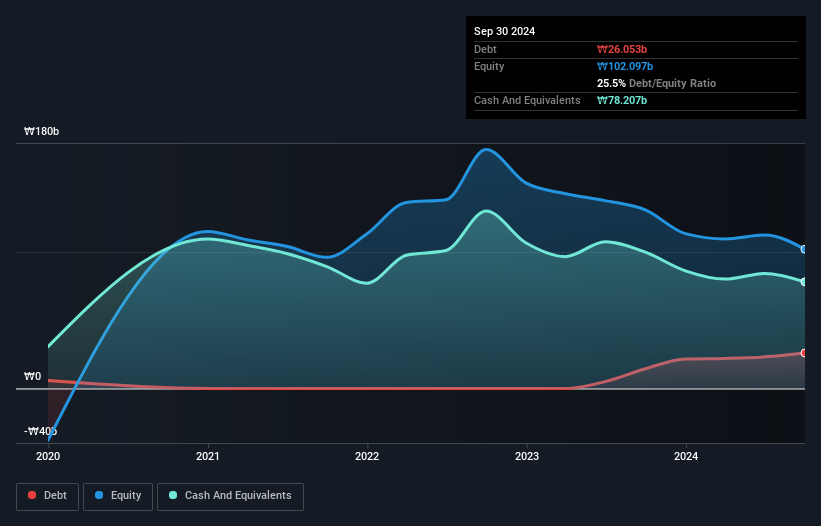- South Korea
- /
- Biotech
- /
- KOSDAQ:A314130
Here's Why Genome (KOSDAQ:314130) Can Manage Its Debt Despite Losing Money

Howard Marks put it nicely when he said that, rather than worrying about share price volatility, 'The possibility of permanent loss is the risk I worry about... and every practical investor I know worries about.' It's only natural to consider a company's balance sheet when you examine how risky it is, since debt is often involved when a business collapses. As with many other companies Genome & Company (KOSDAQ:314130) makes use of debt. But the real question is whether this debt is making the company risky.
What Risk Does Debt Bring?
Debt assists a business until the business has trouble paying it off, either with new capital or with free cash flow. In the worst case scenario, a company can go bankrupt if it cannot pay its creditors. While that is not too common, we often do see indebted companies permanently diluting shareholders because lenders force them to raise capital at a distressed price. Having said that, the most common situation is where a company manages its debt reasonably well - and to its own advantage. The first step when considering a company's debt levels is to consider its cash and debt together.
Check out our latest analysis for Genome
What Is Genome's Debt?
The image below, which you can click on for greater detail, shows that at September 2024 Genome had debt of ₩26.1b, up from ₩14.4b in one year. But on the other hand it also has ₩78.2b in cash, leading to a ₩52.2b net cash position.

A Look At Genome's Liabilities
We can see from the most recent balance sheet that Genome had liabilities of ₩29.4b falling due within a year, and liabilities of ₩20.3b due beyond that. Offsetting this, it had ₩78.2b in cash and ₩2.67b in receivables that were due within 12 months. So it can boast ₩31.2b more liquid assets than total liabilities.
This surplus strongly suggests that Genome has a rock-solid balance sheet (and the debt is of no concern whatsoever). Having regard to this fact, we think its balance sheet is as strong as an ox. Simply put, the fact that Genome has more cash than debt is arguably a good indication that it can manage its debt safely. When analysing debt levels, the balance sheet is the obvious place to start. But you can't view debt in total isolation; since Genome will need earnings to service that debt. So if you're keen to discover more about its earnings, it might be worth checking out this graph of its long term earnings trend.
Over 12 months, Genome reported revenue of ₩24b, which is a gain of 66%, although it did not report any earnings before interest and tax. Shareholders probably have their fingers crossed that it can grow its way to profits.
So How Risky Is Genome?
Statistically speaking companies that lose money are riskier than those that make money. And the fact is that over the last twelve months Genome lost money at the earnings before interest and tax (EBIT) line. Indeed, in that time it burnt through ₩26b of cash and made a loss of ₩36b. While this does make the company a bit risky, it's important to remember it has net cash of ₩52.2b. That kitty means the company can keep spending for growth for at least two years, at current rates. With very solid revenue growth in the last year, Genome may be on a path to profitability. Pre-profit companies are often risky, but they can also offer great rewards. There's no doubt that we learn most about debt from the balance sheet. But ultimately, every company can contain risks that exist outside of the balance sheet. For example, we've discovered 3 warning signs for Genome that you should be aware of before investing here.
If, after all that, you're more interested in a fast growing company with a rock-solid balance sheet, then check out our list of net cash growth stocks without delay.
New: Manage All Your Stock Portfolios in One Place
We've created the ultimate portfolio companion for stock investors, and it's free.
• Connect an unlimited number of Portfolios and see your total in one currency
• Be alerted to new Warning Signs or Risks via email or mobile
• Track the Fair Value of your stocks
Have feedback on this article? Concerned about the content? Get in touch with us directly. Alternatively, email editorial-team (at) simplywallst.com.
This article by Simply Wall St is general in nature. We provide commentary based on historical data and analyst forecasts only using an unbiased methodology and our articles are not intended to be financial advice. It does not constitute a recommendation to buy or sell any stock, and does not take account of your objectives, or your financial situation. We aim to bring you long-term focused analysis driven by fundamental data. Note that our analysis may not factor in the latest price-sensitive company announcements or qualitative material. Simply Wall St has no position in any stocks mentioned.
About KOSDAQ:A314130
Genome
A clinical stage biotechnology company, researches and develops novel-targeted immuno-oncology therapeutics in the field of immuno-oncology, skin diseases, and autism in South Korea.
Excellent balance sheet and slightly overvalued.
Market Insights
Community Narratives




